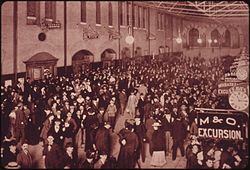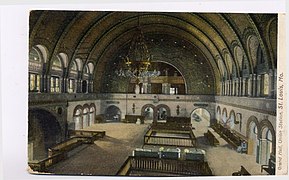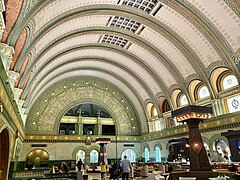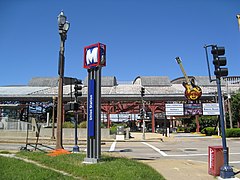
Union Station is a major railway station and intermodal transportation hub in Toronto, Ontario, Canada. It is located on Front Street West, on the south side of the block bounded by Bay Street and York Street in downtown Toronto. The municipal government of Toronto owns the station building while the provincial transit agency Metrolinx owns the train shed and trackage. Union Station has been a National Historic Site of Canada since 1975, and a Heritage Railway Station since 1989. It is operated by the Toronto Terminals Railway, a joint venture of the Canadian National Railway and Canadian Pacific Railway that directs and controls train movement along the Union Station Rail Corridor, the largest and busiest rail corridor in Canada.

Dallas Union Station, officially Eddie Bernice Johnson Union Station, also known as Dallas Union Terminal, is a large intermodal railroad station in Dallas, Texas. It is the third busiest Amtrak station in Texas, behind Fort Worth Central Station and San Antonio station. It serves DART Light Rail Blue and Red lines, Trinity Railway Express commuter rail and Amtrak intercity rail. It is located on Houston Street, between Wood and Young Streets, in the Reunion district of Downtown Dallas. The structure is a Dallas Landmark and is listed on the National Register of Historic Places.

The Eads Bridge is a combined road and railway bridge over the Mississippi River connecting the cities of St. Louis, Missouri and East St. Louis, Illinois. It is located on the St. Louis riverfront between Laclede's Landing, to the north, and the grounds of the Gateway Arch, to the south. The bridge is named for its designer and builder, James Buchanan Eads. Work on the bridge began in 1867, and it was completed in 1874. The Eads Bridge was the first bridge across the Mississippi south of the Missouri River. Earlier bridges were located north of the Missouri, where the Mississippi is smaller. None of the earlier bridges survive, which means that the Eads Bridge is also the oldest bridge on the river.

Baltimore Penn Station, formally named Baltimore Pennsylvania Station in full, is the main inter-city passenger rail hub in Baltimore, Maryland. Designed by New York City architect Kenneth MacKenzie Murchison (1872–1938), it was constructed in 1911 in the Beaux-Arts style of architecture for the Pennsylvania Railroad. It is located at 1515 N. Charles Street, about a mile and a half north of downtown and the Inner Harbor, between the Mount Vernon neighborhood to the south, and Station North to the north. Originally called Union Station because it served the Pennsylvania Railroad and Western Maryland Railway, it was renamed to match other Pennsylvania Stations in 1928.

Dearborn Station was, beginning in the late 1800s, one of six intercity train stations serving downtown Chicago, Illinois. It remained in operation until May 1, 1971. Built in 1883, it is located at Dearborn and Polk Streets, adjacent to Printers Row. The station was owned by the Chicago & Western Indiana Railroad, which itself was owned by the companies operating over its line. The station is now a shopping mall housing office, retail, and entertainment spaces.

Saint Paul Union Depot is a historic railroad station and intermodal transit hub in the Lowertown neighborhood of the city of Saint Paul, Minnesota, United States. It serves light rail, intercity rail, intercity bus, and local bus services.

Chicago Union Station is an intercity and commuter rail terminal located in the West Loop neighborhood of the Near West Side of Chicago. The station is Amtrak's flagship station in the Midwest. While serving long-distance passenger trains, it is also the downtown terminus for six Metra commuter lines. Union Station is just west of the Chicago River between West Adams Street and West Jackson Boulevard, adjacent to the Chicago Loop. Including approach and storage tracks, it covers about nine and a half city blocks.

Union Station, also known as Pennsylvania Station and commonly called Penn Station, is a historic train station in Downtown Pittsburgh, Pennsylvania. It was one of several passenger rail stations that served Pittsburgh during the 20th century; others included the Pittsburgh & Lake Erie Railroad Station, the Baltimore and Ohio Station, and Wabash Pittsburgh Terminal, and it is the only surviving station in active use.

Alexandria Union Station is a historic railroad station in Alexandria, Virginia, south of Washington, D.C. To avoid confusion with nearby Washington Union Station, the station is often referred to as simply Alexandria. Its Amtrak code is ALX.

Nashville's Union Station is a former railroad terminal designed by Richard Montfort, chief engineer of the Louisville and Nashville Railroad (L&N), and built between 1898 and 1900 to serve the passengers of the eight railroads that provided passenger service to Nashville, Tennessee, at the time, but principally the L&N. Built just west of the downtown area, it was spanned by a viaduct adjacent to the station and positioned to the east and above a natural railroad cut, through which most of the tracks in the area were routed. The station was also used by streetcars prior to their discontinuance in Nashville in 1941.

Springfield Union Station is a train and bus station in the Metro Center area of Springfield, Massachusetts. Constructed in 1926, Springfield Union Station is the fifth-busiest Amtrak station in the Commonwealth, and the busiest outside of Greater Boston.
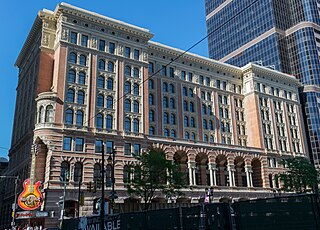
The Reading Terminal is a complex of buildings that includes the former Reading Company main station located in the Market East section of Center City in Philadelphia, Pennsylvania, United States. It comprises the Reading Terminal Headhouse, Trainshed, and Market.

Memphis Central Station, referred to as Grand Central Station prior to 1944, is a passenger terminal in Memphis, Tennessee. Located along Main Street and G.E. Patterson Boulevard in Downtown Memphis, it currently a service stop for Amtrak's City of New Orleans route, arriving in late evening northbound and in the morning southbound. It is also served by the MATA Trolley system. The building was opened in 1914, and is located within the city's South Main Arts District. It is also an contributing property to the South Main Street Historic District of the National Register of Historic Places, as are the National Civil Rights Museum and other historic properties within the district boundaries.
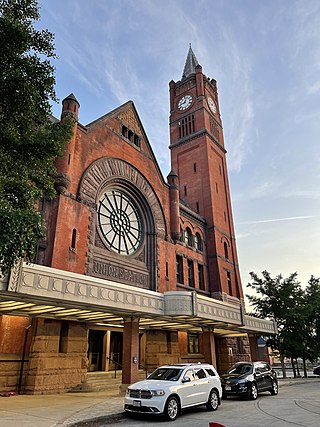
The Indianapolis Union Station is an intercity train station in the Wholesale District of Indianapolis, Indiana. The terminal is served by Amtrak's Cardinal line, passing through Indianapolis three times weekly.

Little Rock Union Station, also known as Mopac Station, is a train station in Little Rock, Arkansas, United States served by Amtrak, the national railroad passenger system.

The Gulf, Mobile and Ohio Passenger Terminal is a historic train station in Mobile, Alabama, United States. Architect P. Thornton Marye designed the Mission Revival style terminal for the Mobile and Ohio Railroad. It was completed in 1907 at a total cost of $575,000. The Mobile and Ohio merged with the Gulf, Mobile and Northern Railroad in 1940 to form the Gulf, Mobile and Ohio Railroad.

Kansas City Union Station is a union station opened in 1914, serving Kansas City, Missouri, and the surrounding metropolitan area. It replaced a small Union Depot from 1878. Union Station served a peak annual traffic of more than 670,000 passengers in 1945 at the end of World War II, quickly declined in the 1950s, and was closed in 1985.

The Gateway Multimodal Transportation Center, also known as Gateway Station, is a rail and bus terminal station in the Downtown West neighborhood of St. Louis, Missouri. Opened in 2008 and operating 24 hours a day, it serves Amtrak trains and Greyhound and Burlington Trailways interstate buses. Missouri's largest rail transportation station, it is located one block east of St. Louis Union Station.

The St. Louis Freight Tunnel is a historic railroad tunnel beneath Washington Avenue and Eighth Street in downtown St. Louis, Missouri. Completed in 1874, it carried freight and passenger trains between the Eads Bridge and the rail yards in the Mill Creek Valley, bypassing busy downtown streets. Today it is used by MetroLink, the light rail transit system in Greater St. Louis.


